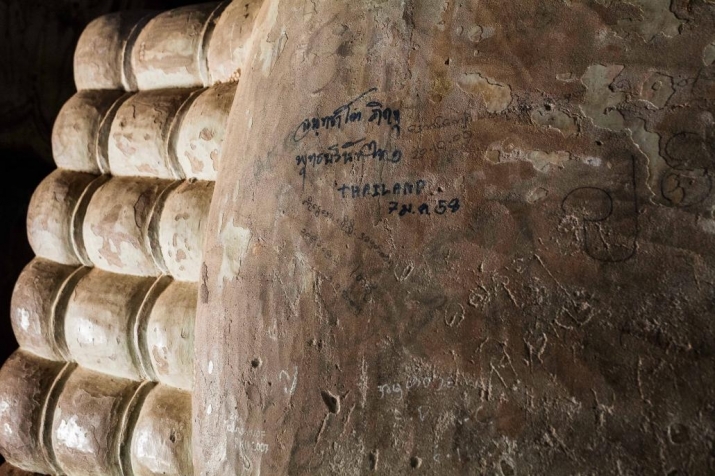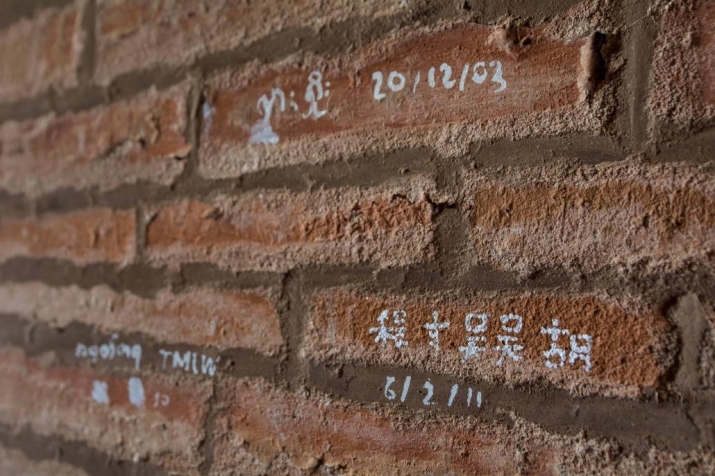NEWS
Disrespectful Visitors the Bane of Bagan’s Ancient Buddhist Monuments
 Bagan at dawn. From wikipedia.org
Bagan at dawn. From wikipedia.orgThe thousands of ancient Buddhist stupas, temples, and monasteries that dot the landscape of Myanmar’s historic city of Bagan have survived numerous upheavals and disasters over the centuries, from wars and the decline in the kingdom’s influence, to floods and earthquakes.* The latest threat to the region’s architectural treasures comes from a seemingly more benign source—Myanmar’s burgeoning tourism industry, which has resulted in hundreds of visitors defacing the monuments, including some of Bagan’s best-known temples, with graffiti.
The Bagan Archaeological Zone in Myanmar’s Mandalay Region is one of the country's principal tourist attractions and a popular destination for Buddhist pilgrims, who come to visit the thousands of ancient Buddhist sites scattered over a 42-square-kilometer plain ringed by mist-covered mountains. While many of the monuments are crumbling and overgrown, others have been restored in recent years in cooperation with UNESCO.
 Bagan's growing popularity as a tourism destination comes with unexpected drawbacks. Photo by Teza Hlaing. From frontiermyanmar.net
Bagan's growing popularity as a tourism destination comes with unexpected drawbacks. Photo by Teza Hlaing. From frontiermyanmar.netThe problem of graffiti is not entirely new, with some of the hundreds of examples defacing the monuments dating back decades—in one instance to 1958. Typically consisting of the visitor’s name and a date, or a declaration of love, the inscriptions appear in a variety of languages, including Chinese, English, Japanese, and Thai, as well as Burmese. Disrespectful visitors have also damaged the ancient structures by climbing on them and stealing bricks.
But because Bagan’s temple-studded plain covers such a wide area, monitoring all of the archaeological sites in the area is an impossibility with the resources and manpower at hand. Educating people about the benefits of preserving their cultural heritage may be the only sustainable approach to protecting the area's wealth of heritigae sites. However, not all visitors welcome having their behaviour criticized. Staff from the Department of Archaeology, which is overseen by Myanmar’s Ministry Culture, said they often receive rude responses from visitors they catch in the act of adding to the graffiti. “When we try to stop people from scribbling on the wall, people talk to us rudely,” said one temple guard. “They say to us, ‘Who are you to interrupt me?’” (Frontier Myanmar)
 The problem of graffiti in Bagan is not entire new, with some examples dating back decades. Photo by Teza Hlaing. From frontiermyanmar.net
The problem of graffiti in Bagan is not entire new, with some examples dating back decades. Photo by Teza Hlaing. From frontiermyanmar.netFrom the 9th to the 13th century, the historic city was the capital of the empire of Pagan (849–1297), which became the first kingdom to unify what would later become modern Myanmar. More than 10,000 Buddhist temples, pagodas, and monasteries were constructed on the plains of Bagan during the kingdom’s height from the 11th–13th centuries, of which the remains of some 3,000 temples and pagodas survive to the present day, rivaling Cambodia’s Angkor Wat in terms of beauty and historical significance. The government has been seeking to have Bagan listed as a UNESCO World Heritage Site for several years, but many challenges remain—including poorly executed renovation and damage caused by visitors.
Earlier this year, the government issued a ban on tourists climbing Bagan’s historic sacred monuments, which offer a spectacular vantage points overlooking the expansive plain, particularly at sunrise and sunset. “Bagan's ancient buildings have been there for many years and we are concerned about damaging the pagodas and the danger of hurting people,” the Ministry of Culture said in a statement, citing the case of an American tourist who was hospitalized earlier in the year after falling from one of the pagodas. The statement also cautioned visitors against other culturally insensitive behavior, such as wearing inappropriate clothing, and dancing or sleeping on the monuments. (The Telegraph)
Following objections from tour operators, who feared the move might damage the country’s nascent tourism industry, the government quickly amended the restriction to exempt five designated pagodas from the ban.
 View over the plain of Bagan. From wikipedia.org
View over the plain of Bagan. From wikipedia.orgThe number of foreign visitors to Bagan has soared since political reforms began in Myanmar in 2011, when the Bagan Archaeological Zone attracted just over 100,000 visitors. In 2015, 250,000 tourists visited the area—in addition to large numbers of domestic visitors—with some 150,000 foreign visitors recorded in the first seven months of this year.
* Three Dead, Scores of Ancient Buddhist Temples Damaged in Myanmar Quake (Buddhistdoor Global)
See more
Defacing Bagan (Frontier Myanmar)
Tourists in Burma banned from climbing Bagan pagodas following 'disgraceful' behavior (The Telegraph)
Myanmar makes U-turn on Bagan temple climbing ban (The Telegraph)
Related
Yangon’s Ancient Sule Pagoda Receives a Glistering Facelift (Buddhistdoor Global)
Worst Flooding in Decades Threatens Buddhist Heritage Sites in Myanmar (Buddhistdoor Global)
Curating the Shwedagon Pagoda Museum in Myanmar (Buddhistdoor Global)
Sacred Stupas and Precious Pagodas: The Many Roles of Reliquaries in the Buddhist Landscape (Buddhistdoor Global)














